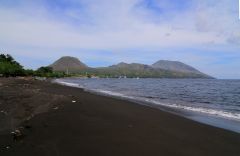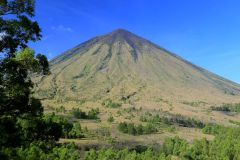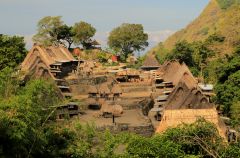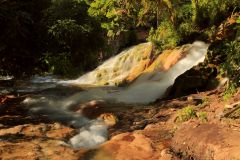Crossing Flores, slooowly
Few pains in the ass and few delights of traveling across Flores, such as hedonism reaching its heights at thermal springs.
I’ve seen many bad, slow, dizzying roads during my travels, but Flores is the worst of them all. It even beats Nepal, and that says something. The roads themselves are not so bad, usually paved all the way, but the terrain is just horrible. Flores is volcanic to the utmost possible level, and hence it’s all deep valleys, steep cliffs and not a single stretch of 100m of straight road. And Indonesian buses (actually minibuses, normal buses couldn’t really travel on these roads) make journey across Flores a true “delight”. Jammed double to triple of their reasonable capacity, including chickens, tons of rice and even broken motorcycles, blasting with Indonesian pop music, which I regards as the worst music in the world (even Indian pop music suddenly sounds as a form of high-art), leg room designed for 6 year old children and stopping every kilometer to onboard another person with another rice bag. I travelled 50% by these public buses and 50% by “private mass transport cars”, alternative to minibuses which are slightly more expensive, but too much (they are mostly used by the locals), usually carrying 5-7 persons and which provide room for a much more convenient sitting position. Honestly, without my yoga practice and cultivation of meditative patience I don’t think I would really survive the bus rides in Flores. And surely not so without anti motion-sickness pills.
What it leads to is that after every day when I had to take a bus ride (usually around 100-150kms in 5-7 hours) I had to take a rest day, doing mostly nothing just recuperating from the joys of Flores transport. As one French traveler put it: “I wanted to see much more, but Indonesia doesn’t really help you to do more…”.
But at least the scenery was fabulous.
While I imagined Flores as a relatively untouristed place, it’s really only relatively untouristed. Sure it’s completely empty compared to Bali, but completely crowded compared to Timor.
From Kelimutu I headed to Bajawa, stopping for few hours in uninspiring city of Ende (just to break the bus ride) sitting amidst wonderful jungle-volcanic scenery. In Bajawa I visited two more traditional villages and hot springs. I can almost hear you screaming “Oh no, traditional villages, he will bore us to death again with endless descriptions of the villages!” but worry not, there’s not too much to say really. These traditional villages were very well accessible from Bajawa and thus flooded by tourists, and so while the places were very beautiful and featuring ages old stone altars, the villagers were mostly souvenir ikat sellers or minded their own rural business. As always you had to sign a guestbook. In Bena, the most beautiful but the most visited of the easily accessible villages, there were more visitors this year than in Boti in Timor during the last 15 years, so this gives you the picture.
Locals are officially Christians, but they also try to please the local deities by animal sacrifice: pigs, buffaloes and horses.
The hot springs in Soa were a true highlight, definitely the best thermal baths I have ever seen. While in Europe we have all those fancy mechanic toys ready for us – Jacuzzi, bubble massage, and various high pressure current and pseudo-waterfalls, here in Soa there was simply a creek of hot water which changed into small waterfall and met a creek of slightly cooler water, natural swimming holes with hot water springing from beneath… simply 100% natural stuff that was so much better than its Western mechanic counterparts. Just sit under the waterfall, find the spot with right temperature and right pressure and you’re in thermal paradise. It would be even more delighting if it wasn’t 30 degrees outside which somehow limited the need for splurging in the hot water, but at least it gave you something to recall during the freaking cold nights.



